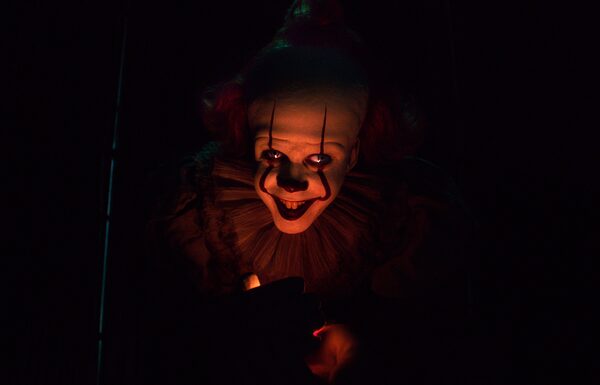
In the Muschiettis’ first attempt at distilling King’s novel, 2017′s It Chapter One, there were two quick Easter egg-y references to the turtle Maturin, but no actual appearance.Brooke Palmer/The Associated Press
Walking into an interview last week with Andy and Barbara Muschietti, the brother-sister creative force behind the highest-grossing horror movie of all time, I was told that I had just seven minutes to talk with them before my time would be cut off. Normally this would have been as terrifying a prospect as facing the many bogeymen populating the Muschiettis’ filmography. Yet, this time I was remarkably calm. Mostly because, as a Stephen King obsessive, I only had one real question to ask the pair: What about the turtle?
In King’s epic novel It, a group of childhood friends battle an intergalactic monster who prefers to take the shape of a terrifying clown named Pennywise. But our heroes, who give themselves the self-deprecating nickname the Losers’ Club, have help in their quest to kill the cackling evil: Maturin, a giant turtle who hails from an ancient universe and is the yin to Pennywise’s yang. (Listen: It is a massively weird book.)
In the Muschiettis’ first attempt at distilling King’s novel, 2017′s It Chapter One, there were two quick Easter egg-y references to Maturin, but no actual appearance. When that film opened to record-breaking numbers, eventually earning US$700-million worldwide, a sequel was inevitable. Which meant that there was another slim chance that It Chapter Two, which focuses on the Losers’ Club as adults, would finally deliver what the Stephen King faithful have been praying for: some sweet, half-shell action. Spoiler alert: that doesn’t really happen. But it is not as if Andy, the director of both films (Barbara serves as the producer), isn’t a fan of the turtle. Quite the opposite.
“I love the turtle, I do, but there are several aspects to it why it doesn’t work here,” the director says, seated the other day in a blood-red corner of the Toronto “geek bar” Storm Crow Manor, which is what would happen if a Jack Astor’s decided that every day was Halloween. “I really wanted to keep the perspective of this story through the human experience. The moment you go to the other side, the macroverse, it becomes a different kind of film – a fantasy. Suddenly, the magic and mystery of what’s on the other side is revealed, like a magician explaining his trick. This is a supernatural story, but let’s keep the mystery.”
Besides, there are plenty of other mysteries to explore in the Toronto-filmed It Chapter Two, such as how the Muschiettis were able to get the children from the first movie to essentially look the same despite the actors having aged two years between shooting. The answer: CGI de-aging.
“It’s a different kind of de-aging, though, one that hasn’t been done before like, say, Kurt Russell in the second Guardians of the Galaxy,” says Barbara, who produced and co-wrote Andy’s 2013 horror hit, Mama. “It’s not taking an older adult and smoothing them out. This age difference is brutal, because their entire face changes completely – they’ve gone from children to adults and we have to bring them back to childhood. We’re enlarging their heads, softening their shoulders, making noses smaller, and also altering their voices.”
Another central mystery: How on earth did the Muschiettis convince studio Warner Bros. to buy a record-amount of fake blood for one crucial and gross scene in the new film?

The first It opened Sept. 8, 2017 to record-breaking numbers, eventually earning US$700-million worldwide.Warner Bros. Pictures/The Associated Press
“It wasn’t as if I planned to have the most blood ever, that’s not something I wanted. But yeah, they said that’s the most blood ever used in a movie,” Andy says, referencing one point mid-film that finds Losers’ Club member Beverly (Jessica Chastain, the director’s old Mama star) nearly drowning in buckets of viscous goo. “The special-effects team built this huge container of blood that would pour into the set. And they stuck a metre tape to measure how many gallons was there. It kept going higher and higher.”
Perhaps the desire to bust through the blood barrier was subconsciously related to the other records the Muschiettis were tasked with breaking, namely the speed at which they had to turn a sequel around.
The first It opened Sept. 8, 2017, and, says Barbara, “we were told opening weekend that the second film was now dated to Sept. 6, 2019. At that point we had no script. So in two years, we wrote a script, casted, filmed, worked through postproduction, and released. It was a very fast train.”
“I felt the heat at the very end, in postproduction, because the movie grows as you’re making it,” adds Andy. “The visual effects really are crazy, and there’s a lot of back and forth with that. The director’s cut was three hours and 25 minutes.”
The final version isn’t quite as long – although at two hours and 49 minutes, it is easily the lengthiest major-studio film in recent memory. But there is also good reason to hope that Muschietti’s original cut – or, rather, one big “super-cut” that combines both films – sees the light of day.
Andy says: “Maybe in the longer version, you’re going to see ...”
"Keep it a surprise!" his sister interrupts.
“The turtle is always there,” he continues with a laugh. “Watching them. Protecting them? Maybe. Maybe.”
It Chapter Two opens Sept. 6
 Barry Hertz
Barry Hertz